Mexican sunflower, scientifically known as Tithonia rotundifolia, is a vibrant and eye-catching plant, known for its bright orange, sunflower-like blooms. Growing Mexican Sunflower from seed is an easy and inexpensive way to add height and drama to your garden.
Growing to a mature height of 4 to 6 feet and spreading approximately 2 to 3 feet, this annual plant makes a bold statement in any garden setting.
Native to Mexico and Central America, Mexican sunflower thrives in warm, sunny climates and is well-suited to USDA Hardiness Zones 3 through 11.
It prefers full sun exposure and well-drained soil, and is particularly noted for its ability to attract butterflies and other pollinators.
When to Start Growing Mexican Sunflower from Seed

The timing for sowing Tithonia seeds depends on your climate zone:
In Zones 3-5
Begin sowing seeds indoors about 6-8 weeks before the last expected frost date. This head start is crucial in cooler climates to ensure the seedlings are robust enough for transplanting.
You can direct sow in the garden after the danger of frost has passed and the soil has warmed, typically in late spring. However, Tithonia can take a while to mature, so you’re best off starting them indoors before spring.
In Zones 6-8
Start seeds indoors 4-6 weeks before the last frost date to extend the flowering period. Direct sow in early spring, after the last frost, for summer blooms. We recommend starting indoors to give Mexican Sunflowers enough time to mature and bloom before fall.
In Zones 9-12
In warmer climates, starting seeds indoors can be done about 4-6 weeks before the last frost date to plant out in spring. You can also start them indoor nearly any time of the year to plant out in spring, summer, or fall. You can also sow seeds directly in the garden from early spring until late summer.
For all zones, starting seeds indoors can help ensure a longer blooming period. Tithonia seeds typically germinate in about 7-14 days under the right conditions.
How to Start Mexican Sunflower Seeds Indoors
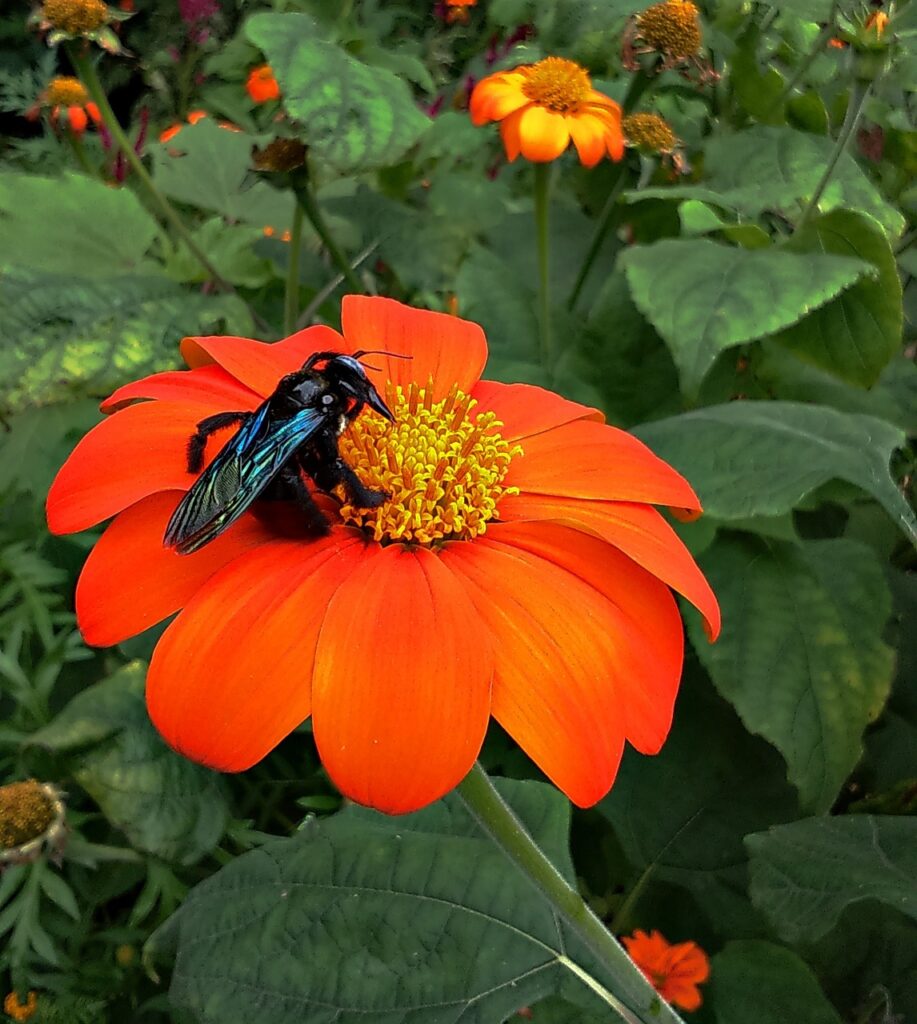
Starting Mexican Sunflower (Tithonia rotundifolia) seeds indoors can give your plants a head start, especially in cooler climates. Here’s a detailed guide on how to effectively start these seeds:
Choosing or Making a Seed Starting Mix
For growing Mexican Sunflower, use a well-draining, nutrient-rich seed starting mix. A mixture containing peat, vermiculite, and perlite is ideal as it provides good aeration and moisture retention, essential for seed germination.
Choosing Containers for Starting Seeds
Choose containers or cell trays that are relatively deep, as Mexican Sunflowers develop a robust root system. Containers or pots that are at least 3-4 inches deep are suitable. This depth allows ample room for root growth and helps the seedlings develop a strong foundation before being transplanted outdoors.
Depth to Plant
Sow the seeds at a depth of about 1/4 inch. Covering the seeds with a thin layer of soil helps maintain the necessary moisture and darkness for germination while allowing for easy emergence of the seedlings.
Moisture Requirement for Seeds
The soil should be kept consistently moist, but not waterlogged. Use a spray bottle to gently mist the soil, ensuring it remains damp. Overly wet soil can lead to seed rot, so it’s important to find a balance.
Optimal Temperature for Germination
Mexican Sunflower seeds germinate best at temperatures between 70-75°F (21-24°C). This temperature range can be maintained in a warm indoor environment or with the use of a heat mat beneath the seed trays if necessary.
Light Requirements for Germination
Provide bright, indirect light for the seeds to germinate effectively. A sunny windowsill or a grow light can ensure they receive enough light without being scorched by direct sunlight.
Time to Germination
Under optimal conditions, expect the seeds to germinate within 5-10 days. However, this can vary based on environmental factors such as temperature and light.
How to Prepare Garden Bed for Planting Mexican Sunflower
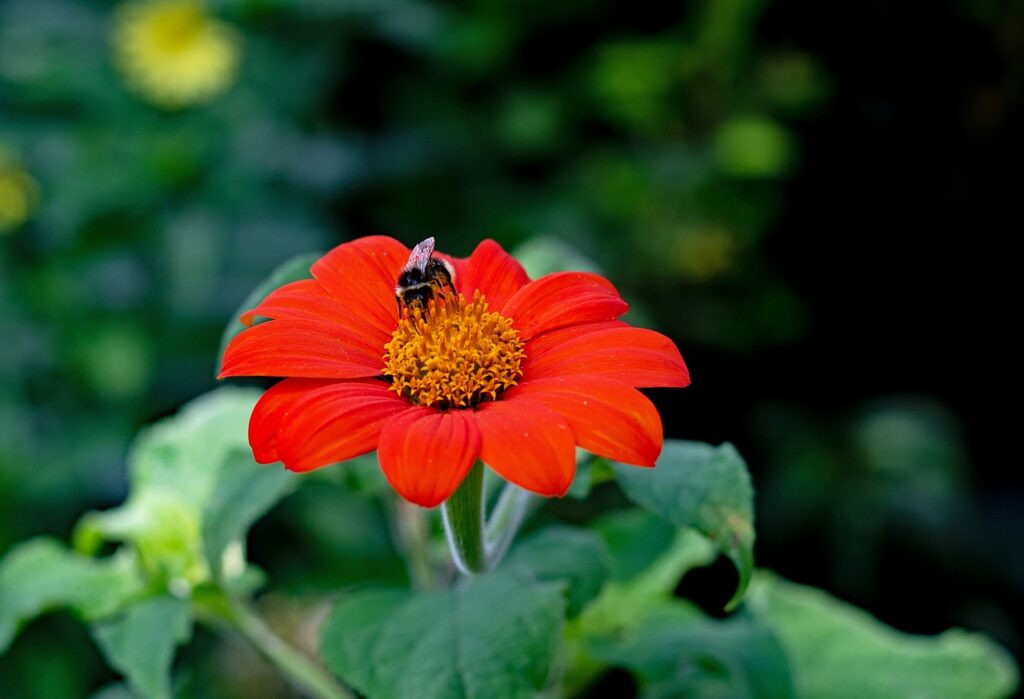
To ensure the successful growth of Mexican Sunflower (Tithonia rotundifolia), preparing your garden bed appropriately is key. Here’s how to do it, following a no-till/no-dig approach:
Choosing a Location
Mexican Sunflowers require full sun to thrive. Select a location that receives at least 6-8 hours of direct sunlight per day.
Choose a spot with well-drained soil. While these plants can tolerate some drought, they perform best when the soil retains moisture without becoming waterlogged.
Tithonia is adaptable and can grow in a variety of soil types. However, they prefer fertile, loamy soil with a neutral to slightly acidic pH. Rich in organic matter is ideal.
Preparing the Garden Bed for Growing Mexican Sunflower
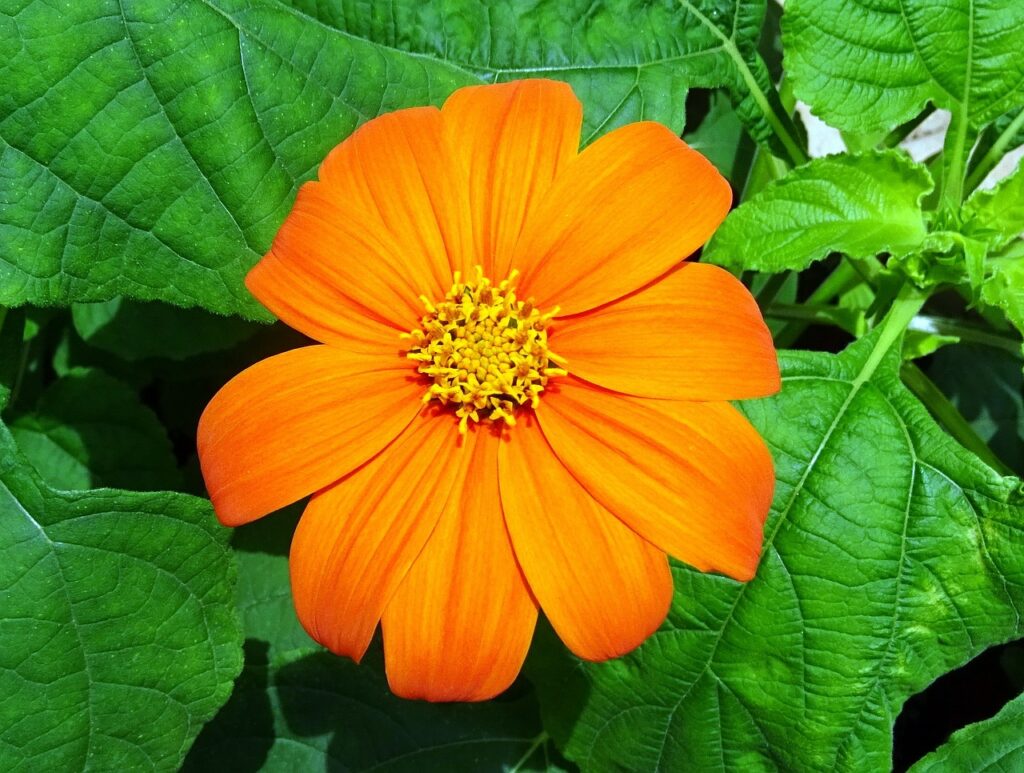
Remove any large debris, stones, and persistent weeds from the area. This can be done by hand or using a rake, being careful not to disturb the soil structure underneath.
Enhance the soil by adding layers of compost, well-rotted manure, or leaf mold on top of the soil. This will slowly integrate into the soil, improving its fertility and structure without the need for tilling.
Apply a layer of organic mulch, such as straw, wood chips, or grass clippings, on top of the compost. This helps retain moisture, suppress weeds, and gradually improves soil quality as it decomposes.
If possible, prepare your bed a few weeks in advance of planting to allow the organic matter to start breaking down and integrating into the soil.
Before planting, ensure the soil moisture is adequate.
Direct Sowing Mexican Sunflower
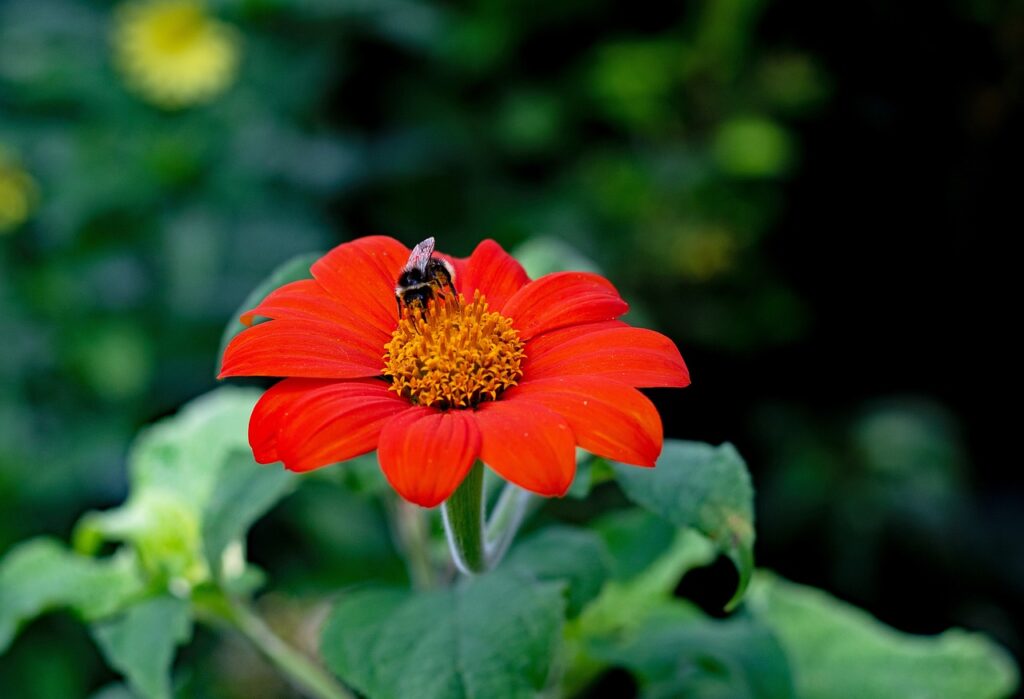
Growing Mexican Sunflower by direct sowing seeds into your garden is a straightforward process that can yield vibrant results. Here’s how to effectively sow these seeds:
Depth to Plant
Plant the seeds at a shallow depth of about 1/4 inch. Lightly cover the seeds with soil, ensuring they are not too deep, as Tithonia seeds need some light to germinate effectively.
Spacing
Scatter the seeds over the chosen area or plant them in rows. If sowing in rows, space them about 2-3 feet apart to give each plant ample room to grow. Mexican Sunflowers can grow quite large and bushy, so providing enough space is key.
Watering In After Planting
After sowing, water the area gently but thoroughly. The soil should be moistened to help with seed germination, but avoid overwatering which can displace or rot the seeds. A watering can with a gentle spray setting is ideal for this.
Thinning
Once the seedlings have emerged and are a few inches tall, thin them to about 2-3 feet apart. Thinning is important as it ensures that each plant has enough space and resources to develop fully. This spacing is particularly important for Mexican Sunflowers due to their size at maturity.
Mulching
Apply a light layer of organic mulch around the seedlings. Mulch helps retain soil moisture, suppresses weeds, and keeps the soil temperature stable. Be cautious not to cover the young seedlings completely with mulch.
How to Know When Your Mexican Sunflower is Ready to Plant Out
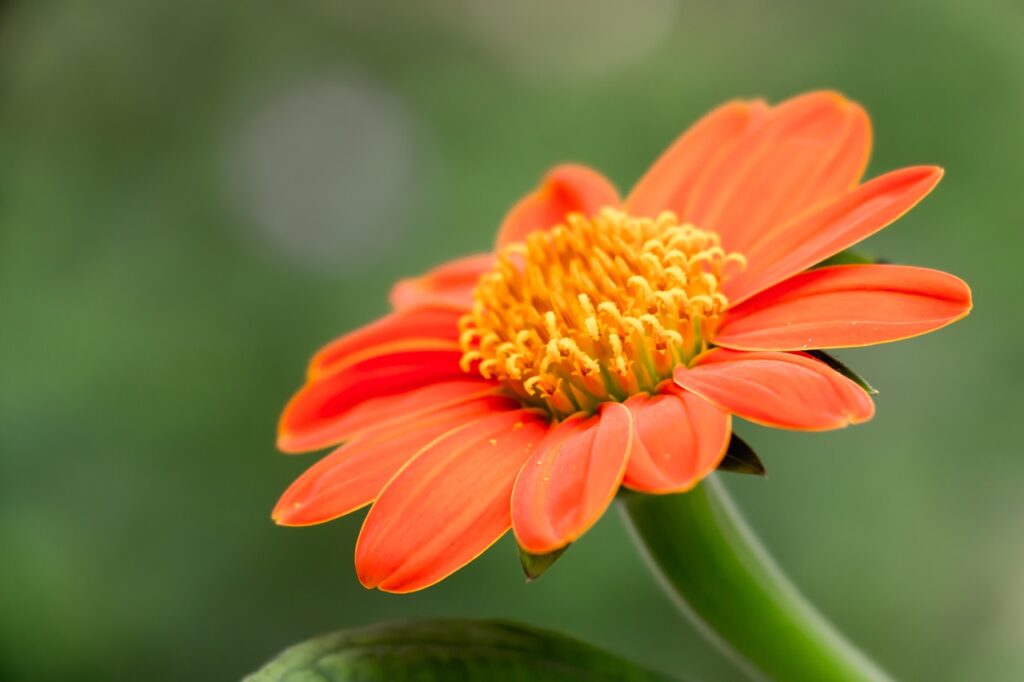
Determining the right time to transplant your Mexican Sunflower starter plants is essential for successful growth in the garden or larger containers. Here are the key indicators:
Size and Development
Mexican Sunflower starter plants are ready for transplanting when they are about 3-4 inches tall and have developed several sets of true leaves, indicating a strong, healthy growth.
Root Development
Gently remove a plant from its starter container to check the roots. If the roots are well-formed, visible, and starting to fill the container without being overly crowded, the plant is ready for transplant.
Planting Out Mexican Sunflower Starters
Once your Mexican Sunflower starters are ready, follow these steps to plant them out in your garden:
Depth
Plant the starters at the same depth they were growing in their containers. This helps the plants adjust without experiencing shock or root exposure.
Spacing
Space the plants about 2-3 feet apart. Mexican Sunflowers grow large and need ample space to develop fully. Proper spacing ensures each plant receives enough sunlight and air circulation.
Mulching
After planting, apply a light layer of organic mulch around the plants. Mulch helps conserve soil moisture, suppress weeds, and maintain an even soil temperature. Avoid piling mulch directly against the plant stems to prevent rot.
Watering In After Planting
Water the transplants thoroughly after planting. This initial watering helps settle the soil around the roots and provides essential moisture for the plants to start establishing themselves. Ensure consistent moisture, especially during the first few weeks after planting, to support healthy growth.
Supporting
Generally, Mexican Sunflowers don’t require support as they have sturdy stems. However, in windy areas or if individual plants are particularly tall and prone to bending, you might use small stakes for support.
Caring for Mexican Sunflower
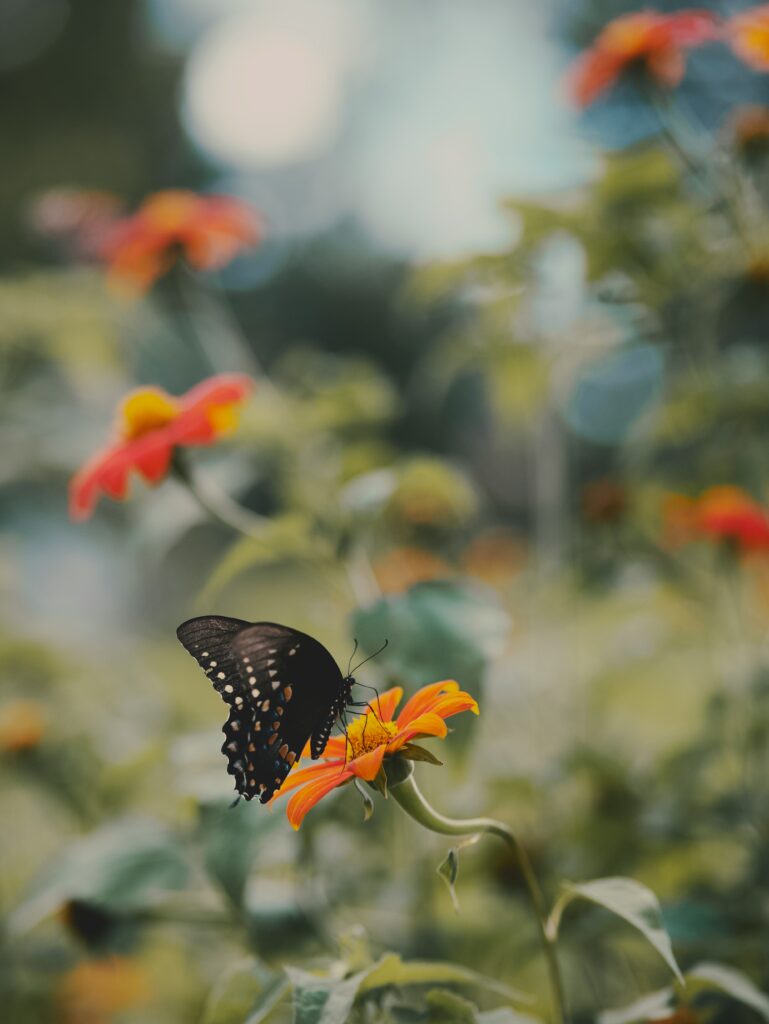
Caring for Mexican Sunflower involves regular watering, occasional feeding, and routine weeding. These vibrant plants are relatively low-maintenance but respond well to consistent care, especially in their growing and blooming stages.
Watering
Water Mexican Sunflowers thoroughly, particularly during dry spells. They prefer consistent moisture but are also drought-tolerant once established. Avoid overwatering, as they do not fare well in waterlogged soil. Allow the soil to dry out slightly between waterings.
Feeding
Feed your Mexican Sunflowers with a balanced, all-purpose fertilizer once or twice during the growing season. A light application in early spring and another in mid-summer can promote healthy growth and vibrant blooms. Avoid over-fertilizing, as too much nitrogen can encourage foliage growth at the expense of flowers.
Weeding
Keep the area around your Mexican Sunflowers weed-free. Weeds can compete for nutrients and water, hindering the growth of your flowers. Regular weeding and a layer of mulch can help maintain a clean and healthy garden bed.
Tips and Tricks for Growing Mexican Sunflower
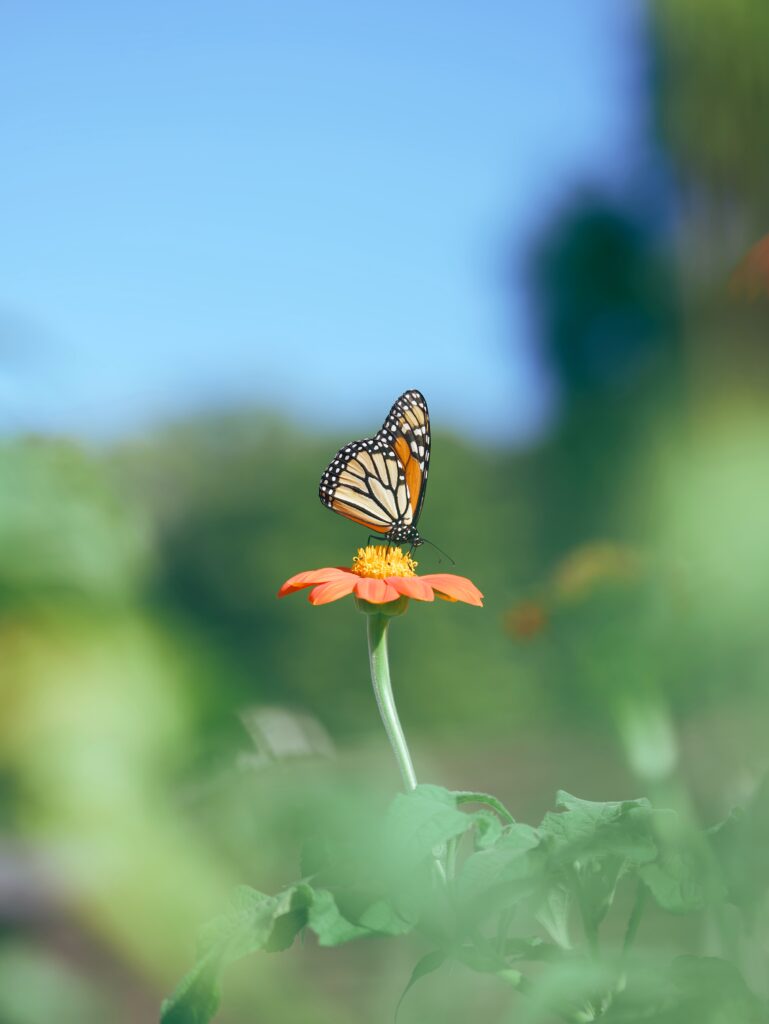
Successfully growing Mexican Sunflower (Tithonia rotundifolia) involves some specific practices to ensure the best growth and flowering. Here are some valuable tips and tricks:
Pinching Back
Pinching back Mexican Sunflowers during the early stages of growth can encourage bushier plants. When the plant is about 6-8 inches tall, pinch off the top growing tips to promote side branching.
This practice can lead to more stems and potentially more flowers, making the plant fuller and more robust.
Support Requirements
Generally, Mexican Sunflowers have sturdy stems and do not require support in most garden settings.
However, in areas with high winds or in situations where the plants become exceptionally tall and are at risk of toppling, you may provide support. Use garden stakes and soft ties to gently support the plants if necessary.
Additional Tips
Full Sun: Plant Mexican Sunflowers in a location that receives full sunlight for vibrant blooms.
Soil Condition: They prefer well-drained soil but can tolerate poor soil conditions. Avoid overly rich soil to prevent leggy growth.
Watering Practice: Water deeply and allow the soil to dry between waterings. Overwatering can lead to root rot.
Deadheading: Regularly remove spent flowers to encourage continued blooming throughout the season.
Attracting Pollinators: Mexican Sunflowers are excellent at attracting butterflies, bees, and other beneficial pollinators. Plant them in areas where you wish to encourage pollinator activity.
Space Appropriately: Given their size, ensure adequate space between plants for optimal growth and air circulation.
How to Harvest Mexican Sunflower for Cut Flowers
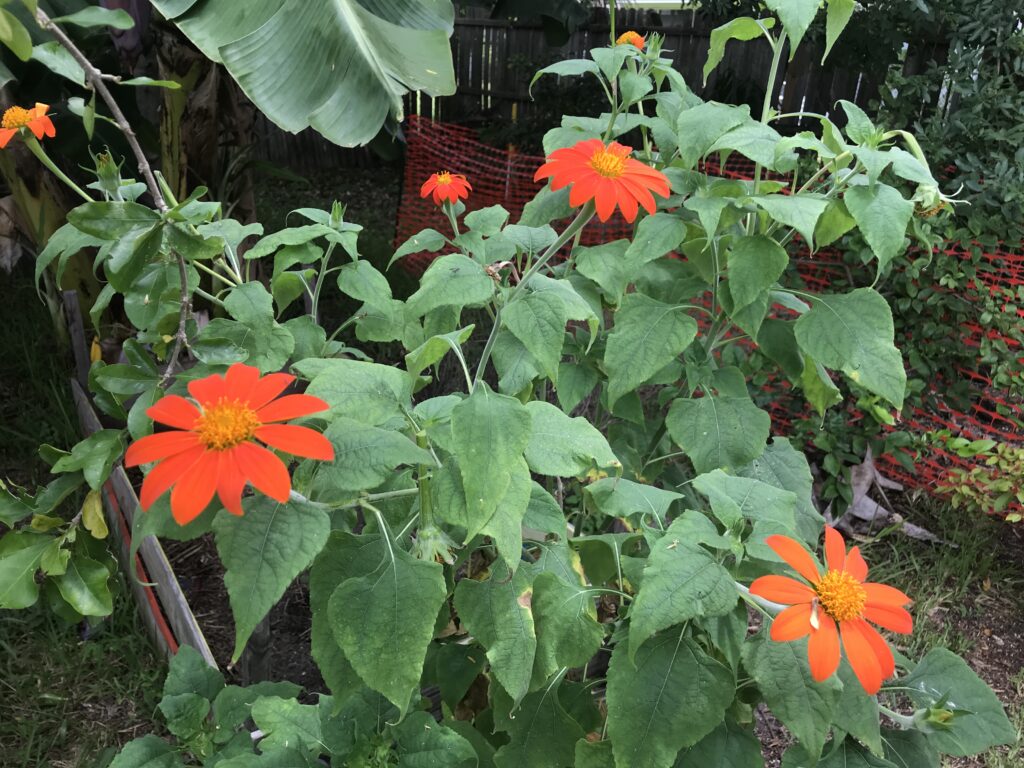
Harvesting Mexican Sunflowers for cut flowers can add a splash of vibrant color to your indoor spaces. Here’s how to do it:
Harvest in the early morning when the flowers are most hydrated. Choose blooms that have just fully opened for the best vase life.
Use sharp scissors or pruning shears to cut the stem. Make the cut at an angle to increase the surface area for water uptake.
Place the cut stems in a bucket of water immediately after cutting. This keeps them hydrated until you’re ready to arrange them.
Before arranging in a vase, remove any leaves that will be below the waterline to prevent rotting.
Change the water in the vase every two days to keep the flowers fresh.
How to Harvest Mexican Sunflower Seeds for Replanting
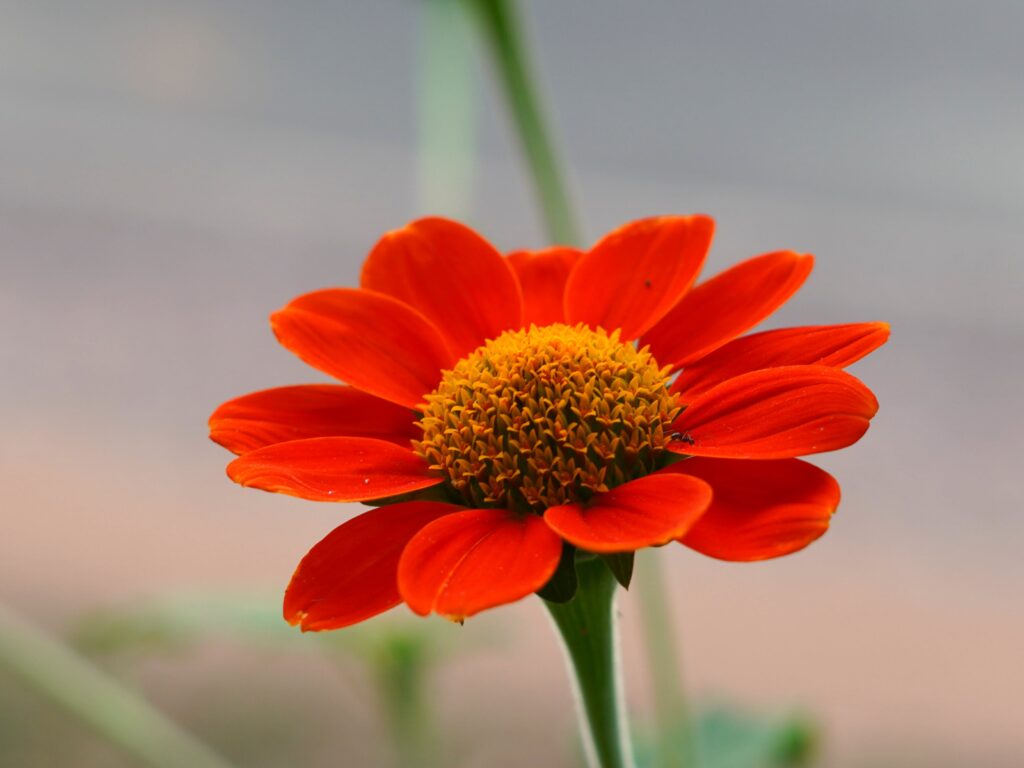
Collecting seeds from your Mexican Sunflowers allows you to propagate these magnificent plants:
After flowering, allow the seed heads to dry on the plant until they turn brown.
Carefully cut the dried seed heads and place them in a container or bag.
Let the seed heads dry further indoors in a warm, dry place.
Gently break apart the dried seed heads to release the seeds. The seed heads are sharp, so wear gloves!
Store the seeds in a cool, dry place in a paper envelope or airtight container until you’re ready to sow them again.
What to Expect from Mexican Sunflower Over Winter

Mexican Sunflower, being an annual, completes its lifecycle in one growing season:
After seeding, the plants will naturally die off. These plants do not survive the winter and will not return the following season.
If you leave some flowers to go to seed, they may self-seed in your garden for growth the next year.
Growing Mexican Sunflower from seed brings a striking beauty to your garden. These tall, vibrant flowers not only enhance the visual appeal of your outdoor space but also attract a plethora of pollinators.
Mexican Sunflowers offer a unique and captivating presence. Their ease of care and dramatic appearance make them a favorite among gardeners of all levels.





